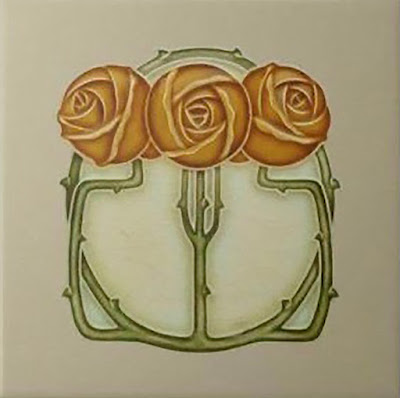It’s been a little while since I posted any new majolica reproductions but manufacturers certainly haven’t slowed down in copying Victorian designs. While some of these are being legitimately sold as majolica style pieces, others are not, being misrepresented as antique pottery. This time though, there is a new area of reproductions one needs to look out for—reproduction Victorian tiles.
The tiles being reproduced are, for the most part, being legitimately sold as exactly what they are, reproductions. One of the companies making these tiles is the English company Stovax Limited who sells them for fireplace use. What concerns me though is that many of these will eventually find their way to secondary market dealers who may, through ignorance or not, sell them as genuine antiques. Dozens of designs are being reproduced, both transfer and majolica style tiles. So many in fact that it would be foolhardy to post them all here, but forewarned is forearmed.
Here are some examples of reproduction tiles.
Reproduction Minton tile
Reproduction Minton tile
Reproduction Minton tile
Reproduction George Jones tile
Reproduction majolica art nouveau tile
Reproduction majolica tube lined tile
Reproduction majolica arts and crafts tile
Reproduction majolica art nouveau tile
Reproduction majolica art nouveau tile
Reproduction majolica arts and crafts tile
Reproduction majolica arts and crafts tile
Reproduction Wedgwood majolica art nouveau tile
Reproduction Malkin majolica tile
Many transfer designs are also being reproduced including the Wedgwood Helen Miles calendar tiles we wrote about
here.
Reproduction Wedgwood November transfer tile
Reproduction Wedgwood August transfer tile
Reproduction Wedgwood December transfer tile
Reproduction Wedgwood May transfer tile
Reproduction Wedgwood May transfer tile
Reproduction Minton Spring transfer tile
Reproduction Minton transfer tile
The best way to recognize these new tiles is by the reverse. Most antique tiles by major manufacturers are clearly marked, but not all. For that reason being familiar with the craftsmanship of antique tiles is important. Antique tiles are thick while the reproductions are thinner. Antique tiles are also usually ridged or patterned on the reverse to better attach to wet plaster. New tiles are smooth on the reverse, to adhere to modern sheet rock. Some of these new tiles are screen printed using modern printing methods distinguishing them from three dimensionally formed tube lined antique tiles.
Reverse of Minton Hollins & Co. tile showing old adhesive
Reverse of Minton Hollins & Co. tile showing mark
Most antique tiles find their way to the market after removal from buildings so one often finds old adhesive on the back or sides of antique tiles. Keep an eye open for that in lieu of a marking.

























No comments:
Post a Comment